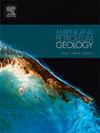U-Pb ages of pre- to post-salt carbonates, Santos and Campos basins, SE Brazil: Implications for the evolution of the South Atlantic
IF 3.7
2区 地球科学
Q1 GEOSCIENCES, MULTIDISCIPLINARY
引用次数: 0
Abstract
The exploration campaigns and independent studies conducted in the central South Atlantic basins after the discovery of giant oil accumulations in the Lower Cretaceous lacustrine carbonates sealed by the salt layer resulted in a new panorama of the tectonic framework, stratigraphic architecture, and petroleum systems of the investigated basins and passive margins in general. Despite these remarkable advances, the ages of the carbonate reservoirs and the sealing evaporites remain uncertain. Aiming to fill this gap, we present here the results of 30 U-Pb LA-ICP-MS calcite and dolomite age determinations representative of the depositional/eo-diagenetic processes and subsequent phases of carbonate cementation recorded by pre-to post-salt units of the Santos and Campos basins of southeastern Brazil. Microcrystalline calcite of a mudstone of the Itapema Formation (Santos Basin) yielded a minimum age of 126.8 ± 4.7 Ma. 19 depositional/eo-diagenetic ages obtained in mudstones, grainstones, shrubstones, spherulitestones, and travertines of the correlative Barra Velha and Macabu pre-salt lacustrine carbonates cluster around 124.1 ± 2.2 and 122.1 ± 2.3 Ma. Considering the errors, these results limit the deposition/eo-diagenesis of these units to the 126.2–120.0 Ma interval. Two determinations carried out in calcite laminae of a nodular anhydrite sample extracted from the lower portion of the Retiro Evaporite (Campos Basin) returned the ages of 119.2 ± 1.6 Ma and 119.18 ± 0.79 Ma, which we interpreted as the best approximation of the timing of the salt deposition. Analyses performed in 3 samples from the post-salt Quissamã carbonates (Campos Basin) provide a minimum age of 114.2 ± 2.8 Ma yielded by interparticle dolomite cement. Other phases of calcite and dolomite cements present in the investigated units were dated at ca. 119.4, 116.5, and 110.7 Ma. The stratigraphically coherent spectrum of ages obtained differs significantly from most available data, providing a new perspective for the ongoing discussions on the tectonic evolution of the South Atlantic and probably impacting the current views of the burial history and petroleum system of the Santos and Campos basins.
巴西东南部桑托斯和坎波斯盆地盐前至盐后碳酸盐岩的 U-Pb 年龄:对南大西洋演变的影响
在被盐层封存的下白垩统湖相碳酸盐岩中发现巨型石油储藏后,在南大西洋中部盆地开展了勘探活动和独立研究,为所调查盆地和整个被动边缘的构造框架、地层结构和石油系统勾勒出一幅新的全景图。尽管取得了这些重大进展,但碳酸盐岩储层和封存蒸发岩的年龄仍不确定。为了填补这一空白,我们在此展示了 30 项 U-Pb LA-ICP-MS 方解石和白云石年龄测定的结果,这些结果代表了巴西东南部桑托斯和坎波斯盆地盐前至盐后单元所记录的沉积/渗生过程和碳酸盐胶结的后续阶段。伊塔佩马地层(桑托斯盆地)泥岩中的微晶方解石的最小年龄为 126.8 ± 4.7 Ma。在相关的 Barra Velha 和 Macabu 盐前湖相碳酸盐岩的泥岩、纹理石、灌木石、球状石和洞穴石中获得的 19 个沉积/生态二源年龄分别为 124.1 ± 2.2 Ma 和 122.1 ± 2.3 Ma。考虑到误差,这些结果将这些单元的沉积/生态成因限定在 126.2-120.0 Ma 之间。对从雷蒂罗蒸发岩(坎波斯盆地)下部提取的一个结核状无水石膏样本的方解石层进行的两次测定得出了 119.2 ± 1.6 Ma 和 119.18 ± 0.79 Ma 的年龄,我们将其解释为盐沉积时间的最佳近似值。对来自盐后基萨芒碳酸盐岩(坎波斯盆地)的 3 个样本进行的分析表明,颗粒间白云石胶结的最小年龄为 114.2 ± 2.8 Ma。调查单位中存在的其他方解石和白云石胶结物的年代约为119.4、116.5 和 110.7 Ma。所获得的地层一致的年龄谱与大多数现有数据有很大不同,为正在进行的关于南大西洋构造演化的讨论提供了一个新的视角,并可能影响目前对桑托斯和坎波斯盆地的埋藏史和石油系统的看法。
本文章由计算机程序翻译,如有差异,请以英文原文为准。
求助全文
约1分钟内获得全文
求助全文
来源期刊

Marine and Petroleum Geology
地学-地球科学综合
CiteScore
8.80
自引率
14.30%
发文量
475
审稿时长
63 days
期刊介绍:
Marine and Petroleum Geology is the pre-eminent international forum for the exchange of multidisciplinary concepts, interpretations and techniques for all concerned with marine and petroleum geology in industry, government and academia. Rapid bimonthly publication allows early communications of papers or short communications to the geoscience community.
Marine and Petroleum Geology is essential reading for geologists, geophysicists and explorationists in industry, government and academia working in the following areas: marine geology; basin analysis and evaluation; organic geochemistry; reserve/resource estimation; seismic stratigraphy; thermal models of basic evolution; sedimentary geology; continental margins; geophysical interpretation; structural geology/tectonics; formation evaluation techniques; well logging.
 求助内容:
求助内容: 应助结果提醒方式:
应助结果提醒方式:


